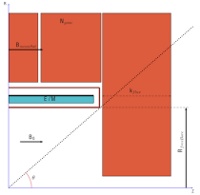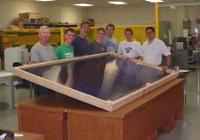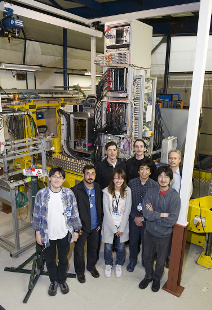 |
|
|
 |
CLIC-ILC collaborations on detectors
This month's Research Director's Report was written by François Richard, co-chair of the Worldwide Study, regional detector contact for Europe

Parametric model for the magnet coil and yoke (from Alain Hervé). This concept is common to CMS, ILD, SiD and CLIC. |
The recent meeting TILC09 in Tsukuba, with a large participation of CERN experts, was a good opportunity to measure the growing collaboration between the Compact Linear Collider Study (CLIC) and the ILC. Here I will only describe the detector aspects which are part of the Memorandum of Understanding (MOU) agreement signed between ILC and CLIC (see Barry Barish's corner in November 2008). This agreement results from the evident common interests of the two communities in machine and detector studies and the need to avoid potentially detrimental competition. In the past, physics arguments in favour of extending the centre of mass energy of the worldwide linear collider beyond 1 TeV were based on speculations. With the imminent start of LHC, not forgetting the present essential results from the Tevatron, we all agree that the choice can soon be based on solid observations.
Read more...
-- François Richard
Research Director's Report Archive |
 |
|
|
 |
Upcoming meetings, conferences, workshops
11th European Symposium on Semiconductor Detectors
Wildbad Kreuth Conference Center, Bavaria, Germany
7-11 June 2009
Tesla Technology Collaboration Meeting (TTC09)
LAL, Orsay, France
16-19 June 2009
ILC-CLIC LET Beam Dynamics Workshop at CERN
CERN, Switzerland
23-25 June 2009
Polarized Positron for Linear Colliders Workshop (Posipol 2009)
IPNL, Lyon, France
23-26 June 2009
FCAL meeting
DESY Zeuthen, Germany
29-30 June
Upcoming schools
The 2009 Hadron Collider Physics Summer School
CERN
8-17 June 2009
Summer School on Particle Physics, Cosmology and Strings
Perimeter Institute, Waterloo, Canada
24 June - 1 July 2009
International School of Physics "Enrico Fermi" (SIF)
Radiation and particle detectors
Varenna, Villa Monastero, Italy
20-25 July
|
|
|
GDE Meetings calendar
View complete ILC calendar
|
|
|
 |
University of Notre Dame collaborates on muon detector development project

ILC prototype crew at University of Notre Dame gathered around the muon detectors built on-site. |
Most particle physicists think that the International Linear Collider (ILC) could revolutionise our understanding of the universe, and will challenge inquisitive minds of particle physics. This is a field where University of Notre Dame in Notre Dame, Indiana, US, has been actively participating, particularly in muon detector research and in organising outreach activities between students, high school teachers and physicists.
Read more...
-- Andre Sulluchuco |
 |
|
|
 |
 |
|
|
 |
From Associated Press
19 May 2009
European scientists launch new space telescope
...Unlike Hubble, which has become famous for its breathtaking images of the heavens, Herschel and Planck work in non-visible wavelengths of light. But they will provide scientists with crucial information about planet and star formation.
Read more... |
|
From Reuters
14 May 2009
Austria to stay in particle physics lab after all
"Austria has been a member of CERN for over 50 years -- a whole host of Austrian scientists are linked to CERN and will continue to do so in the future," Faymann, a social democrat, said at a news conference with Science Minister Johannes
Read more... |
|
From Wiener Zeitung
14 May 2009
Ritt auf Plasmawelle soll Elektronen effizienter aufladen
...Während im LHC Protonen zusammenprallen, haben die Max-Planck-Wissenschafter mit Kollegen der Universitäten in Düsseldorf und Novosibirsk ein Konzept für einen International Linear Collider (ILC) vorgeschlagen, um Elektronen zu beschleunigen.
Read more... |
|
From INFN
14 May 2009
Important step-forward towards the SuperB realization
...The main result of the test is reported in the figure where one can clearly see the gain in luminosity obtained when applying the "crab-waist" configuration for the interaction region.
Read more... |
|
From Público
8 May 2009
La extinción de los mastodontes de la física
...El caso del ILC muestra que la construcción de máquinas cada vez mayores y más potentes para explorar los abismos de la física puede tener cerca su límite. Tevatrón, el acelerador en activo más energético, costó unos 200 millones de euros; LHC, siete veces más potente, 5.000.
Read more... |
|
|
 |
Learning accelerator science

Bruno Touschek developed the first generation of electron-positron colliders at Frascati, Italy in the 1960s. |
Today I want to encourage young researchers interested in becoming accelerator scientists to consider applying to participate in our "Fourth International Accelerator School for Linear Colliders." It will be held from 7 to 18 September 2009 near Beijing, China, and the application deadline of 1 June is fast approaching. Our previous schools have been extremely successful, presenting unique opportunities to learn the basics of accelerator science from leaders in the field, and to study challenging applications for a next-generation linear collider. In addition, this year’s school will include two tracks, one on radiofrequency (rf) technology and one on accelerator physics, offering more in-depth learning for returning and more advanced students.
Read more...
-- Barry Barish
Director's Corner Archive |
 |
|
|
 |
Calorimeters in test beam at Fermilab

Some members of the CALICE collaboration stand in front of the calorimeters currently at Fermilab's Meson Test Area. Back row: (left to right) Frank Simon, Nils Feege, Jose Repond. Front row: (left to right) Shunsuke Tozuka, Adil Khan, Miho Nishiyama, Katsushige Kotera and Satoru Uozumi.
Read more about calorimeter testing in Fermilab Today and in Frank Simon's blog entries in Quantum Diaries (see BlogLine).
|
arXiv preprints
0905.2922
Top Quark Physics at the Tevatron
0905.2655
Cosmic Ray Tests of the Prototype TPC for the ILC Experiment
0905.1782
CP-sensitive spin-spin correlations in neutralino production at the ILC
EUROTeV Reports
2008-091
Low-energy Positron Polarimetry at the ILC
2008-093
Final Report for the Laser-wire Beam Position Monitor (LBPM) Task
|
|

